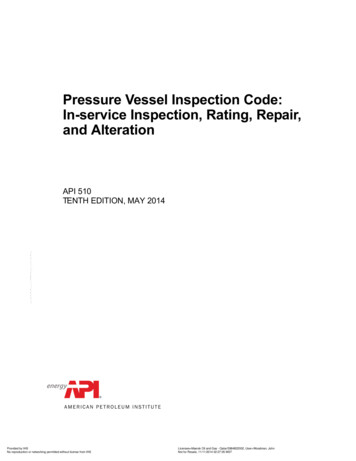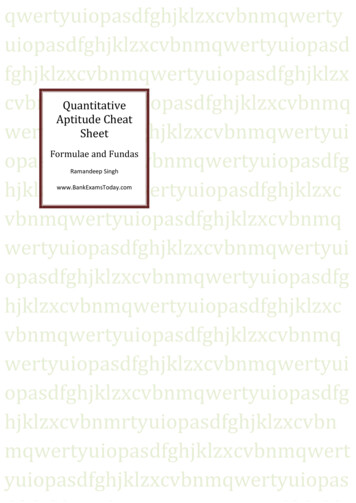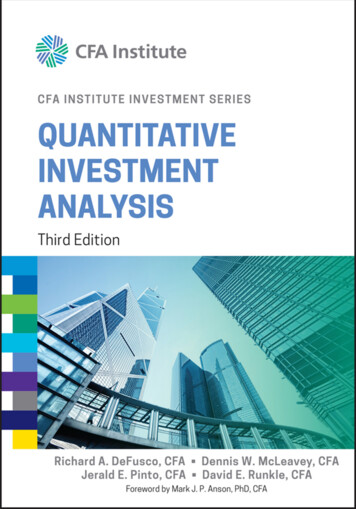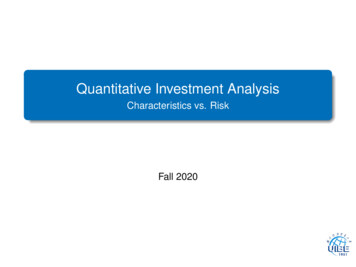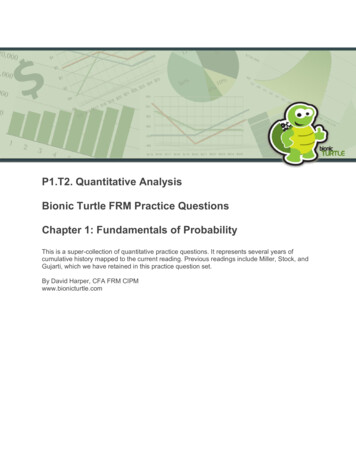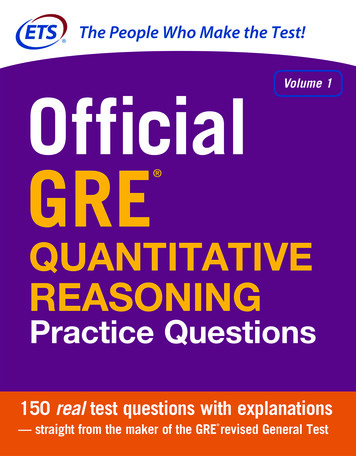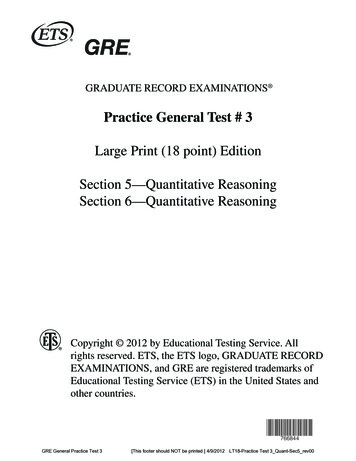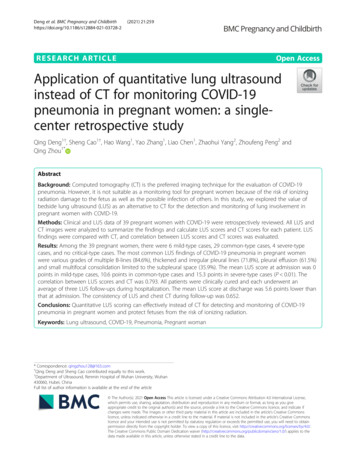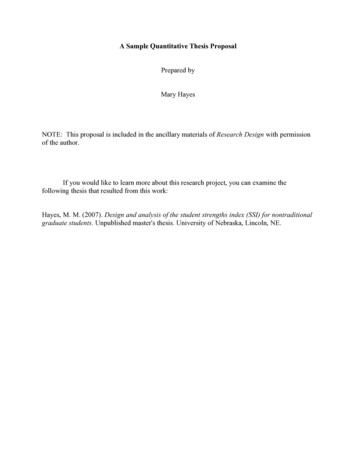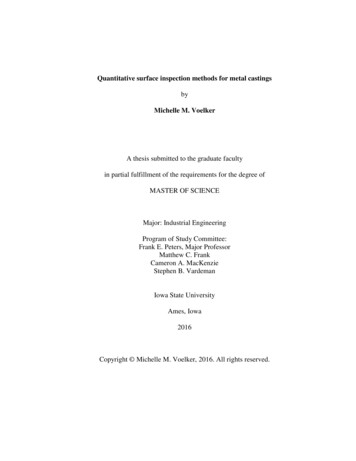
Transcription
Quantitative surface inspection methods for metal castingsbyMichelle M. VoelkerA thesis submitted to the graduate facultyin partial fulfillment of the requirements for the degree ofMASTER OF SCIENCEMajor: Industrial EngineeringProgram of Study Committee:Frank E. Peters, Major ProfessorMatthew C. FrankCameron A. MacKenzieStephen B. VardemanIowa State UniversityAmes, Iowa2016Copyright Michelle M. Voelker, 2016. All rights reserved.
iiTo my family and friendswho have supported me on my educational journeyregardless of how many years it has taken.
iiiTABLE OF CONTENTSLIST OF FIGURES . xiiLIST OF TABLES . ixACKNOWLEDGEMENTS . xABSTRACT . xiCHAPTER 1: INTRODUCTION . 1Research Motivation.4Thesis Organization .4References .4CHAPTER 2: LITERATURE REVIEW . 5Current Inspection Standards .5Surface Metrology .5Point Cloud Manipulation .9References .16CHAPTER 3: RISK ASSESSMENT ON VISUAL INSPECTION METHODS FORCAST METAL SURFACES . 19Abstract .19I. Introduction .19II. Current Visual Inspection Standards .21MSS SP-55 Visual Method . 21ASTM A802 . 22ACI Surface Indicator Scale . 22GAR Microfinish Comparator C9 . 23III. Construction of Influence Diagrams .23Training and Judgement Type . 25Environmental Factors . 27Human Capabilities . 30Defect Density . 31
ivInterpretations . 32IV. Discussion .35V. Conclusions .38VI. Acknowledgements .40VII. References .40CHAPTER 4: DEVELOPMENT OF A DIGITAL STANDARD TO SPECIFYSURFACE REQUIREMENTS OF CAST METAL SURFACES . 44Abstract .44I. Introduction .45II. Current Inspection Standards .45ACI Surface Indicator Scale . 46MSS SP-55 Visual Method . 46ASTM A802-95 . 47BNIF 359 . 48GAR Electroforming Cast Microfinish Comparator C9 . 49Other . 49Summary of Current Standards . 50III. Overview of Quantitative Standard .51VSR 1.85 – 12.00 – 35 . 55VSR 2.32 – 12.00 – 17 . 55VSR 6.00 – 12.00 – 0 . 55Other Variations . 56IV. Discussion .59V. Conclusions .60VI. Acknowledgements .60VII. References .60CHAPTER 5: EVALUATION OF SLICING METHODOLOGIES TO DETERMINEUNDERLYING GEOMETRY OF CAST METAL SURFACES . 62Abstract .62I. Introduction .63II. Previous Work .63III. Exploration of Slicing Methodology for Underlying Geometry .69Segmenting . 76
vMid-point Locus . 77Polynomial. 77Moving Average . 78IV. Results .78V. Discussion.81Geometry Orientation . 85Overfitting . 87Abnormalities . 87VI. Conclusions .88VII. Acknowledgements .88VIII. References .89CHAPTER 6: AN EVALUATION OF SUBSAMPLING METHODOLOGIES FORUNDERLYING GEOMETRY APPLICATIONS IN CAST METAL SURFACES . 90Abstract .90I. Introduction .91II. Previous Work .91III. Methodology .94Point Sampling . 98Strategic Sampling . 99Geometric Shape Sampling . 100Grid Sampling . 101IV. Results and Discussion .101Point Density . 102Abnormalities . 104Sampling Method . 105VI. Conclusions .108VII. Acknowledgements .108VIII. References .109CHAPTER 7: GENERAL CONCLUSIONS . 111General Discussion .111Recommendations for Future Research .112
viAPPENDIX A: QUANTITATIVE INSPECTION ACCEPTANCE CRITERIA FORCAST METAL SURFACES . 116APPENDIX B: GRAPHICAL REPRESENTATION OF SLICING METHODOLOGYRESULTS . 119APPENDIX C: PROPOSED SOFTWARE PROGRAM TO EVALUATE THEVOELKER SURFACE RATIO PARAMETERS . 120
viiLIST OF FIGURESFigure 1.1—Porosity abnormalities on a casting 1Figure 2.1—Example of roughness average calculation 6Figure 2.2—Roughness average comparisons of three unique surfaces 6Figure 2.3—Effects of sample length on mean line calculations . 7Figure 2.4—Point cloud to mesh triangulation methods . 10Figure 2.5—Fitting straight lines through segments to remove curvature . 12Figure 2.6—Fitting polynomials through a surface to remove curvature 12Figure 2.7— Comparison of a best-fit line versus best-fit polynomial . 13Figure 2.8— Use of the mid-point locus line to remove curvature from surface profile. 13Figure 2.9— Morphological filters decomposing surface profile at various band widths. 14Figure 2.10—Normal Gaussian filter compared to robust filter . 15Figure 3.1—MSS Method Example 21Figure 3.2—ACI Surface Indicator Scale . 22Figure 3.3—C9 Cast Microfinish Comparator 23Figure 3.4—Netica model for Type I and II Errors for cast metal surface inspection 24Figure 3.5—Repeatability and reproducibility example . 34Figure 3.6—Base values of error comparing judgment and training type decisions . 36Figure 3.7—Sensitivity analysis of various factors’ worst case on Type I and II errors . 37Figure 4.1—ACI Surface Indicator Scale . 46Figure 4.2—MSS method example of acceptable and non-acceptable cutting marks. . 47Figure 4.3—Comparison of SCRATA and BNIF comparators . 48Figure 4.4—BNIF suggestion table for steel castings . 48
viiiFigure 4.5—C9 Microfinish Comparator . 49Figure 4.6—Parameter calculation process . 54Figure 4.7—Comparison of control limits for each example specification . 54Figure 4.8—Surface profiles of acceptable surfaces as per specifications . 57Figure 5.1—Localized roughness versus best fit plane distance on sample casting 66Figure 5.2—Localized roughness versus best fit plane on D5 SCRATA plate 66Figure 5.3—Localized roughness versus best fit plane on E3 SCRATA plate . 66Figure 5.4. Determining parameters based on shape fitting versus underlying geometry 68Figure 5.5—Slicing method for calculating underlying geometry . 71Figure 5.6—Break down of slicing algorithms 71Figure 5.7—Effects on sliced original shape from central and extrema compression . 72Figure 5.8—Example of curved surface profiles . 74Figure 5.9—Third order polynomial fit to a wavy surface profile 82Figure 5.10— Seg
ii To my family and friends who have supported me on my educational journey regardless of how many years it has taken.
